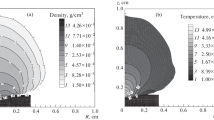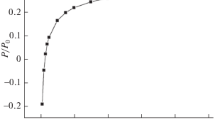Abstract
The radiation gasdynamic processes in the channel of an air laser plasma generator operating at atmospheric pressure are analyzed. In the multigroup approximation a numerical radiation gasdynamic model is formulated on the basis of the equations of motion of a viscous heat-conducting gas and the selective thermal radiation transport equation. Laminar and turbulent subsonic generator operation regimes are considered.
For the purpose of approximately describing the turbulent gas and plasma mixing the Navier-Stokes equations averaged after Reynolds and the k-ε turbulence model are used. The problem is solved in the time-dependent two-dimensional axisymmetric formulation.
Strong radiation-gasdynamic interaction regimes are investigated. In these regimes the energy losses due to radiation from the high-temperature region of the laser plasma and the absorption of its thermal self-radiation by the surrounding plasma and gas layers (radiation reabsorption) appreciably affect the gasdynamic flow structure. Two methods of integrating the selective thermal radiation transport equation in the generator channel are discussed. In one of these the thermal radiation transport is calculated inside the heated volume and in the other the radiation heat fluxes are calculated on the surfaces bounding the volume. The results of calculating the spectral and integral radiation heat fluxes on the inner surface of the generator are given.
Similar content being viewed by others
REFERENCES
I. A. Bufetov, A. M. Prokhorov, V. B. Fedorov, and V. K. Fomin, “Slow laser plasma combustion and steady-state optical discharge in air,” in: Proceedings of General Physics Institute of the USSR Academy of Sciences [in Russian], Vol. 10, 3–74 (1988).
N. A. Generalov, A. M. Zakharov, V. D. Kosynkin, M. Yu. Yakimov, “Stability of a continuous optical discharge in an atmospheric air flow,” Fiz. Gor. Vzryva, 22, No.2, 91 (1986).
G. I. Kozlov, V. A. Kuznetsov, and V. A. Masyukov, “Continuous optical discharge in molecular gases,” Zh. Tekh. Fiz., 49, 2304 (1979).
S. T. Surzhikov and A. A. Chentsov, “Numerical analysis of the stability of a continuous optical discharge in an atmospheric air flow,” Fiz. Plasmy, 22, 1054 (1996).
S. T. Surzhikov, “Radiation-convection heat transfer in the chamber of an optical plasmatron,” Teplofiz. Vysok. Temp., 28, No.6, 1205 (1990).
R. J. Glumb and H. Krier, “Concepts and status of laser-supported rocket propulsion,” J. Spacecraft and Rockets, 21, No.1, 70–79 (1984).
T. S. Wang, Y. S. Chen, J. Liu, L. N. Mirabo, and F. B. Mead, “Advanced performance modeling of experimental laser lightcraft,” J. Propuls. and Power, 18, 1129 (2002).
E. L. Klosterman and S. R. Byron, “Measurement of subsonic laser absorption wave propagation characteristics at 10.6 µm,” J. Appl. Phys., 45, 4751 (1974).
T. V. Loseva and I. V. Nemchinov, “Subsonic radiation waves,” Fluid Dynamics, 28, No.5, 720 (1993).
S. T. Surzhikov, “Numerical analysis of radiation laser slow-combustion waves,” Kvantovaya Elektronika, 30, 416 (2000).
A. Baranovskii, Z. Mukha, and Z. Peradzyns’kii, “Instability of a continuous optical discharge in gases,” Usp. Mekh., 1, No.3/4, 125 (1978).
S. T. Surzhikov, “Bifurcation of subsonic gas flow past a local low-temperature plasma volume,” Teplofiz. Vysok. Temp., 40, No.4, 591 (1990).
S. T. Surzhikov, “Radiation-convection heat transfer in the process of slow motion of a radiating gas in a region of local energy release,” Fluid Dynamics, 32, No.3, 431 (1997).
L. W. Jones and B. E. Launder, “The calculation of low-Reynolds number phenomena with a two-equation model of turbulence,” Intern. J. Heat and Mass Transfer, 16, 1119 (1973).
R. Martinuzzi and A. Pollard, “A comparative study of turbulence models in predicting turbulent pipe-flow,” AIAA J., 27, No.1, 29–36 (1989).
S. T. Surzhikov, Spectral Absorption Coefficients of Hot Atmospheric Gases. Earth’s and Martian Atmospheres [in Russian], Institute for Problems in Mechanics of the Russian Academy of Sciences, Moscow (2004).
M. Capitelli, G. Colonna, C. Corse, and A. D’Angola, “Transport properties of high temperature air in local thermodynamic equilibrium,” The European Physical J., D, 11, No.2, 279 (2000).
S. A. Vasil’evskii, I. A. Sokolova, and G. A. Tirskii, “Exact equations and transport coefficients for a multicomponent gas mixture and a partially ionized plasma,” J. Prikl. Mekh. Tekh. Fiz., No. 4, 15 (1984).
S. T. Surzhikov, Numerical Experiment in Constructing Models of Radiation Gas Dynamics [in Russian], Nauka, Moscow (1992).
S. T. Surzhikov, “Computing system for solving radiative gasdynamic problems of entry and re-entry space vehicles,” in: Proc. 1st Intern. Workshop on Radiation of High Temperature Gases in Atmospheric Entry. Lisbon, Portugal, EAS SP-533 (2003), P. 111.
Yu. V. Lapin and M. Kh. Strelets, Internal Gas Mixture Flows [in Russian], Nauka, Moscow (1989).
S. T. Surzhikov and H. Krier, “Unsteady dynamic variables methods for heterogeneous propellant burning,” AIAA J., 39, 2343 (2001).
B. G. Carlson and K. D. Lathrop, “Transport theory. Discrete ordinates method,” in: H. Greenspan, C. N. Kelber, and D. Okrent (Eds.), Computing Methods in Reactor Physics, Argonne National Laboratory, Gordon and Breach Science Publishers, New York, London, Paris (1969), P. 102–157.
Additional information
__________
Translated from Izvestiya Rossiiskoi Academii Nauk, Mekhanika Zhidkosti i Gaza, No. 3, 2005, pp. 126–143.
Original Russian Text Copyright © 2005 by Surzhikov.
Rights and permissions
About this article
Cite this article
Surzhikov, S.T. Subsonic Radiation Gas Dynamics in a Laser Plasma Generator Channel. Fluid Dyn 40, 446–461 (2005). https://doi.org/10.1007/s10697-005-0084-6
Received:
Issue Date:
DOI: https://doi.org/10.1007/s10697-005-0084-6




